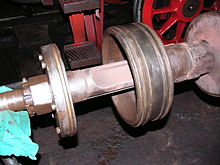Trofimoff slider


The Trofimoff valve (also Trofimov -, Trofimow -, Troffimoff - or Trofimof -) is a springless pressure compensation piston valve for steam engines (especially steam locomotives ).
The Trofimoff slide consists of the slide rod, the slide bodies that can be moved on it and the two support plates. During the load travel, the valve bodies are pressed onto the support plates by the steam pressure and work like regulating piston valves. If the steam supply is switched off or the regulator is closed in the case of a steam locomotive, the steam pressure drops and the valve bodies remain in the inner dead center position near the center of the cylinder due to the piston ring tension. The slide rod moves back and forth without touching the slide body with the support plates attached to it. A complete pressure equalization and thus an excellent idling of the steam engine / locomotive is given.
The support plates attached to the slide rod also carry a piston ring. This dampens the "closing" of the sliding valve body. In narrow-gauge locomotives (for example the DR series 99.23-24 ) these piston rings are not available. With these locomotives you can hear the characteristic clacking noise when switching from idling to running under load. This piston ring on the support body is a further development of the then RAW Meiningen .
So that the entire cylinder block of the locomotive does not have to be changed in the event of damage, the slides run in special bushings. The slide bushing consists of two parts and is pressed into the cylinder block from the front and rear. With special drilling equipment, this socket can be drilled out several times during repairs. On the last photo, the joint of the two bushing halves and rectangular openings are visible in the rear area. These are the steam inflow openings. The steam flows through the inclined slits at the front to the pistons of the steam engine. The front area, outside of the slide bushing, is called the discharge box and opens out via the discharge pipe, the standpipe and the blowpipe head centrally under the chimney of the locomotive. The slide bodies control the gas exchange of the steam engine through their movement (alternating opening and closing of the inclined slots).
